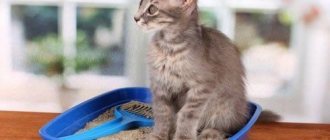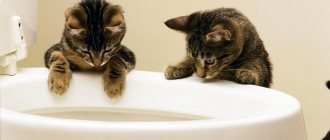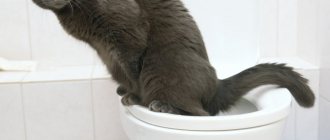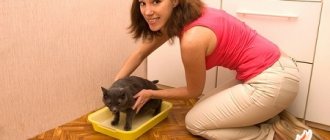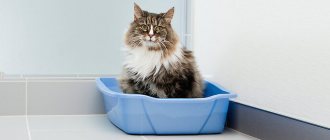Emotions! Chaos! Joy! This is what will reign in your home when you first bring home your new kitten. But while bringing a kitten home is a lot of fun, there are a lot of practical, everyday things to consider to keep him happy in your home. One of the most important is learning how to use the toilet.
It is important to make sure you are prepared and have all the necessary resources and items your kitten needs before bringing him home. One of them is, of course, cat litter and its matching litter box. Don't wait for an "accident" to happen, as this will not help get you or your kitten on the right track.
The following tips will help you prepare in advance by providing everything you need to help your new kitten know where and how to “do her little business.”
Use your instincts
Cats and kittens have a natural instinct to perform hygiene routines with materials such as sand, so if you put out a litter box as soon as he gets home, he will instinctively start using it in no time. You don't have to teach him what to do, just make sure he knows where he is and his cat instincts will kick in on their own!
Both cats and kittens prefer to bury their feces. This is another instinct that helps them mark their territory and hide their presence from predators... so it's important that you provide your kitty with the right litter box.
© shutterstock
Tray filler matters
As for the choice of tray and filler, this is individual and depends on many factors. An open tray with low sides is best for a kitten, but the choice of filler is more variable. If you bought a kitten from a breeder, find out what kind of litter was used in the nursery and purchase the same one. If this is not your first tailed friend and you, as the owner, already have your own preferences, then feel free to follow them. At an early age, kittens are not yet accustomed to one litter or another, so choose the one that is convenient for you.
When choosing
your first filler, we advise beginners to follow the following rules:
- Choose a litter that contains little or no dust, as this can cause discomfort if inhaled by the kitten.
- Do not buy litter with a smell: a strong scent can scare off the animal, and it will begin to look for an alternative place for the toilet.
- Don't start potty training with clumping litter because your kitten will likely want to taste it and this can cause intestinal upset.
Kittens purchased from breeders, as a rule, are already litter box trained and do not cause big problems for their new owners. All that remains is to show them their new home and litter tray. But if you adopted a kitten from the street or separated it from its mother cat too early, you will have to be patient. However, there are practically no “untrained” kittens, and sooner or later your new pet will master all the toilet tricks. You should show flexibility and cunning, and then success will not keep you waiting.
Find the right litter box
The comfort of the “toilet” is important. Your kitten will soon turn into a cat, so choose a large litter box that he can also use when he grows up. But now make sure that your kitten can easily access it and use it without any problems while he is still small.
One option is a toilet with high sides or a roof. These models have advantages :
- Less clutter . Since kittens like to bury their feces, kicking or decomposing sand can create extra mess outside the litter box.
- Privacy . Cats are private animals, and your kitty may want some privacy when going to the bathroom.
- Odor control . While there are many types of cat litter that can absorb unpleasant odors, a covered litter box is a little better at keeping unwanted odors at bay, especially if you can't change the litter often.
But there are also disadvantages:
- The front door can scare a kitten . You can start by introducing him to a sandbox without a door.
- The smells stay inside and he doesn't like it at all.
- He may not like to go into a place where he cannot be aware of his surroundings.
- The edges may be too high for him.
Remember that if you have several cats, you must provide each of them with their own resources. This includes a toilet as well as a spare one so they have more options. Cats don't like sharing a bathroom!
And often they prefer to have a litter tray for pooping and one for peeing...that's how they are...
Method No. 2 – Duplicate tray
This method is my invention. After suffering with the cat for a couple of months, I moved her litter box directly to the toilet, where it was intended to be, according to my plans. And in place of the tray under the sink I put an ordinary large herring tin with a newspaper inside. The can perfectly covered the most attractive place, in the cat’s opinion, and was also securely blocked by the cans standing there, so it was not easy to move it. Now my stubborn girl had a choice of two options: a comfortable, tested tray in a new place - in the toilet, and a small, inconvenient jar, but in a familiar place under the sink.
The choice of cat was obvious. Having broken down a little for the sake of decency, she went straight to her destination. A nuance: the jar stood under the sink until we moved, otherwise the favorite place was immediately used by the cat, just like in the good old days.
Consider the location of the toilet
Just like people, cats like privacy when doing their little things, so make sure their litter box is in a quiet place and away from walking areas. It may be in a corner or a little hidden somewhere.
Make sure the litter box is always accessible and not behind closed doors or near something noisy, such as a washing machine, that might frighten them.
Also, keep the tray away from your kitten's food and water.
After all, people wouldn't eat in our sinks... and cats don't like it either.
Additional Tips
A few additional recommendations will help you quickly train your kitten to the toilet, as well as sort out failures. Sometimes training fails not because the pet is harmful, but for completely objective reasons.
Tray selection
The correct tray is the basis for quick learning. Available on the market:
- Small containers with low sides;
- Deep vessels;
- Entire houses with an entrance.
When purchasing, you should focus on the baby’s preferences, and not designer delights.
Selecting a location
Going to the toilet is an intimate affair, and the container should also be in a secluded place.
Avoid:
- Rooms where doors close spontaneously;
- Area of feeders and water bowls;
- Passage of bustling rooms.
What to do if you can’t train
It happens that all attempts to toilet train a kitten end in failure.
Causes:
- The baby doesn’t like the place - you need to rearrange the container or place several in different parts of the house;
- The cat doesn’t like the litter box - you need to buy a different type;
- The pet is not satisfied with the filler - you should try granules made from other materials;
- The baby is extremely clean - different trays are required for small and large needs;
- Your pet is stressed - perhaps something has changed dramatically in his life, it is necessary to eliminate the stress factor or to reconcile him with the changes with affection, attention and games;
- The kitten is sick - often felines make it clear about diseases, especially urological ones. Extreme attention is necessary if puddles and heaps mainly appear on beds, soft fabrics, sofas ;
- The teenager has entered the puberty phase - the problem is solved by castration or sterilization, if the animal is not intended for breeding.
IMPORTANT! If there are several cats in the house, the number of trays should be equal to their number + 1. For example, for 3 pets a minimum of 4 trays is required.
Teaching a healthy and happy baby to go to the toilet in the right place is quite simple. If something doesn’t work out, then you should take a closer look at either your pet or your own actions. Sometimes small changes in a few days completely correct the situation.
Choose the right cat litter
There are many types of cat litter, but there are a few important things to consider before purchasing:
- Buy cat litter that doesn't stir up dust. Dust from some litters can irritate a cat's lungs.
- Kittens may try to eat sand.
- This may seem like a tempting option, but avoid scented sand. Cats generally cannot tolerate strong odors. Your kitten may find it unbearable and may even irritate his nose or eyes. You can even make him go to another part of the house to relieve himself!
- Make sure you can easily scoop the sand and place it directly into the disposable bag without spilling it.
- Cats are habit animals, so don't change the type of litter too often. Make sure the one you choose is easily accessible.
- If we look at its origins, among its preferences is fine desert sand... look for sand that doesn't interfere with the pads and absorbs well.
Kittens have high standards of hygiene, so be sure to use the litter box every day and clean it regularly, otherwise your kitten will avoid the litter box and go elsewhere.
© shutterstock
Learning to ask to go to the toilet outside
An extremely controversial question raised by many owners is whether it is worth teaching a kitten to go outside to the toilet.
This option is acceptable in 2 cases:
- A private house is surrounded by a fence, and the pet immediately returns back;
- The apartment is on the ground floor, the cat comes home after relieving himself, and the building is located on a quiet street with a front garden.
In situations where there is a possibility of further walking and self-walking, it is strictly not recommended to train a kitten to use the toilet outside due to safety concerns for the small pet.
In a private house
There are 2 options for learning to ask to go outside. The first is effective if the baby knows the tray. You should:
- Gradually move the tray towards the front door until it is right at the exit;
- When this option becomes familiar to the baby, the container must be placed on the porch;
- At first he will continue to use the usual container, but later he will find a suitable pile of earth;
- Usually the first time is enough for the baby to make a choice in favor of the yard;
- In this case, he will really beg, scratching the joint or meowing near the exit to the street.
Other methods require the constant presence of one of the owners in the house, and the latter must pay maximum attention to the pet.
Basic actions:
- Remove the tray from the animal's sight and smell;
- Watch the kitten carefully;
- As soon as he demonstrates by his behavior the need to empty his bowels or bladder, he is taken out into the yard;
- The situation should be repeated daily until the pet himself understands that he has been allocated an area near the house for the toilet.
The last way is to walk with the kitten in nature immediately after eating, waiting until he has had enough of playing and finds a pile of soil for the toilet. It will take several days for the reflex to form: a food bowl is followed by a walk.
In the apartment
The training mechanism is identical to street training in a private house. The only thing you need to choose is whether the cat will go out through the door or jump out the window. For safety reasons, it is recommended that if you live in a city, you accompany your animal by walking it on a harness several times a day.
Considering the time consumption and the pet’s desire to get into all the holes and dense thickets, when living in an apartment, it is better to stick to home toilet options.
Your kitten will trip over the litter box
Keep in mind that there will be some "accident when using your toilet." If your kitten is unable to get comfortable using the litter box right away, or is coping with using the litter box elsewhere in the house, you should thoroughly clean the area to prevent it from returning. Smell is a powerful territorial signal and how cats mark their space, so it's important to eliminate "minor disturbances" in the home.
Be careful not to use bleach or other ammonia based products because they will remind cats of the smell of your urine and they will do it again in that area. Use enzyme soap or warm soapy water as this will remove any remaining kitten urine and ensure that all traces of odor and pheromones are completely gone.
How to toilet train a kitten in one place
Each cat has its own character. Teaching a baby to go to the toilet in one place chosen by the owners can take several weeks, or it can take place in 1 day.
Conditions on which the speed of learning depends:
- The breeder's attention to this issue;
- Volunteer work in a shelter or foster care;
- Features of the street where the baby was taken from.
To the new tray
In the first two cases, training is usually not required: it is enough to bring the pet to a new tray. In the latter, if the animal is not naturally neat, the owner will have to waste time.
General principles of training:
- Planting in a tray after each meal;
- Observing the baby when trying to hide or take a characteristic pose - in this case, you should immediately transfer him to the designated toilet;
- In case of incidents, wet a piece of napkin in urine and put it in a container, the smell will help the kitten orientate itself next time;
- Reward after a successful attempt - affection, verbal praise and specialized treats reinforce the reflex.
It is strictly forbidden to:
- Yelling at your pet will make him angry and may use the corners for his own needs on purpose;
- Poking its muzzle into a puddle or pile - the cat is not able to recognize such actions of the owner as a requirement to visit the litter box
If the pet was taken from breeders, then you should also take a little filler with its smell.
To the toilet with filler
Most owners prefer cat litter with litter. High-quality products perfectly absorb odor and make cleaning the cat litter box easier.
IMPORTANT! For kittens, you should choose litter made exclusively from sawdust. Babies love to play and eat pellets, but other materials can significantly harm your pet's health.
The general principles of training do not change, however, if there is a filler, you should put the baby in the tray and help him dig with his paw. Natural instincts quickly take over: animals love to rummage in the ground, and in natural conditions they use the soil to dig and bury holes.
If the baby was taken from the street, then one of the options is to use the usual soil for the first time, gradually replacing it with the selected filler.
No filler
It is possible to quickly accustom a kitten to a toilet without litter if there are already older cats in the house who use this type of litter box. The characteristic smell of feces and urine will lead him to the right place.
Otherwise, initially you will need a little filler, but after each success the amount should be left less and less. Ultimately, the container will absorb the desired aromas, and the baby will begin to ignore the lack of bulk material.
If you choose a tray without a mesh, you will need a special mat that absorbs moisture. Few felines like getting their paws wet, especially with urine.
Toilet nozzle
The toilet cover is a simulator for accustoming a cat to the toilet and looks like a regular tray. They are installed on the rim of the toilet and are initially used as a regular toilet with filler. As the cat gets accustomed to the tray, a hole is made in the center of the pad, which expands over time. As soon as the animal begins to steadily do its business in the toilet, the nozzle is removed.
Advantages:
- cheaper than a toilet training tray;
- eliminates the spread of unpleasant odors;
- savings on purchasing filler.
Flaws:
How to make a toilet for a cat with your own hands: plastic design
Making a plastic “toilet” for a cat is not at all difficult and does not take long. Some complicated tools won't be useful either. So, to make a “latrine” for a catfish, you will need:
- Plastic container (bath, construction basin).
- Marker, masking tape.
- Hacksaw. It can be replaced with a jigsaw or grinder.
- Coarse sandpaper or file.
- Acrylic paint.
- Take a suitable plastic container.
- Mark the cut location with a marker or tape. You choose the height of the sides yourself, depending on the age, size and individual characteristics of your pet predator.
- Cut off all excess using a jigsaw, hacksaw or grinder. It is not advisable to use scissors for this purpose, as the material may crack.
- Clean the cut areas with sandpaper or a file.
- If desired, paint the container with acrylic paint (preferably from a spray can).
Important! If you take a closed plastic container and cut an entrance into it, you will get a cozy “toilet-house” for a shy pet.
Closed toilet for cats: a cat corner in the owner’s house
Having decided to get a kitten, you should think about buying a toilet for it. It is better to purchase a toilet for a cat right before the animal appears in the house. This will avoid difficulties when training your furry companion to the appropriate place. The range of cat litter today is quite wide. There are options depending on the area of the home and the preferences of the pet itself. But before making a final decision and making a purchase, you should study the details of the issue: which toilet models are distinguished, their advantages and disadvantages, as well as what needs to be taken into account when choosing a product in a store or how to make it yourself.
Some Caveats
The kitten should be seen by a doctor.
A complete examination will allow you to exclude the presence of diseases in the animal that can cause problems in the process of accustoming the animal to the tray. Kittens should be fed only wet and dry food , which is intended only for them. You should not buy formulations intended for adults. This can cause digestive upset in the kitten, leading to undesirable consequences.
There are situations when kittens deliberately do not go to the litter box to relieve themselves, because the owner severely punished him for incorrectly removing the place. The animal may simply be afraid of its toilet. They especially do not like trays located in a visible place. It is better to place the container in a more modest corner. Under no circumstances should you severely punish an offending cat. This will only make the situation worse.
Neat do-it-yourself toilet house for a cat
Everyone loves cats when they snuggle up on the couch, snuggle up, or purr on their laps. But no one likes cleaning cat hair from clothes and repainting torn joints. Today we decided to tackle one specific problem - the tray that constantly catches our eye. The master class will be especially useful for those who, due to the layout of the house, are forced to place the cat litter in a prominent place.
- Plywood with a thickness of 12 to 15 mm for the walls of the house.
- 4 cm wide boards for the roof (about a meter in total).
- Nails and hammer, screws and screwdriver.
- Wood glue (PVA).
- Jigsaw.
- Miter saw (or hacksaw).
- Drill.
- Roulette.
- Two small furniture hinges.
- Template in the form of a cat's head for the door.
- Sandpaper.
- Tracing paper.
- Masking tape.
- Dye.
Decide how big the house will be. It is important that the tray fits into it, so take its dimensions as a basis. Use the diagram below or make the house even larger.
Source
How to make a cat litter box with your own hands
- How to make a cat litter box with your own hands
- How to teach a cat to go to the litter box
- DIY scratching post
- How to get rid of cat odor
- plastic pallet or hard cardboard;
- self-adhesive film or piece of oilcloth;
The easiest way to make a toilet is from a plastic pallet. Take a mesh material (mosquito net or other), cut a rectangle according to the internal size of the tray, cover the edges with tape or self-adhesive film to prevent injuries when changing the toilet. Pour a 1-2 cm layer of sand or sawdust into the tray, cover with a homemade mesh and the tray is ready.
Instead of a metal mesh, you can make a mesh out of cardboard: cut out a suitable rectangle, cover it completely with film and make holes with an awl. The distance between the holes should be no more than 1 cm.
The mesh is needed to prevent the animal from getting its paws wet when urinating. It is easier to remove solid excrement from the screen than to flush it down the toilet along with lumps of sand. Simply brush the screen over the toilet and rinse.
The toilet can also be made from cardboard - cut a box of suitable size, strengthen it by covering it with film or oilcloth. A simple tray isn't enough? Decorate the toilet with a cat's head and letter stickers.
When cutting a tray from a cardboard box, make one side slightly larger than the rest. Cut out something like a cat's head (semicircle and ears) from the remaining cardboard and glue it to the elongated side. Cover the tray with film or oilcloth, and stick letters on the head element in the form of a cat’s name.
Closed tray (toilet-house)
A cat litter box has an aesthetic appearance and is usually liked by furry pets because of the additional sense of security. In shape, such models can look like toy houses, and individual toilet-houses are designer art objects.
When choosing this option, make sure that the closed tray design makes it easy to clean. It may be difficult to train a kitten that is used to an open litter box.
Advantages:
- traps odors;
- prevents the spread of filler outside the toilet;
- There are models of various sizes;
- cats like it because it creates an enclosed space;
- eliminates the pet's mistakes.
Requirements
Before you start working, you need to know which design is preferable. It is important to decide on the size, since the tray should be comfortable for the animal. Otherwise, it will simply do its business where it is more convenient. The pet should be able to take a comfortable position, therefore:
- The best option is a flat, oblong-shaped device.
- If your cat is shy by nature and prefers to cope with large and small needs, an enclosed “house” would be a good solution.
- The depth of the future “toilet” should be no less than 50, but no more than 70-80 mm. If the tray is too shallow, then the filler, swelling, will spill out through the sides.
Important! For animals that like to rummage through the litter, higher sides are desirable. A tray designed for a small kitten should be small in height so that the baby can easily climb in and out of the tray.
As for the material of manufacture, then:
- It is advisable that your DIY cat tray be made of plastic. This is a durable, affordable, and, most importantly, extremely easy-to-care material. It is extremely easy to wash and clean.
- In principle, metal is also a suitable option, but it quickly oxidizes, reacting with the animal’s urine.
- Wood is only suitable for temporary use, as it quickly swells, absorbs moisture, and a constant aroma reigns in the apartment, which is quite difficult to get rid of. For the same reason, a cardboard box for a cat’s “latrine” is not the best option.
How to choose a toilet for cats?
Man has been friends with cats for a long time. We are responsible for what our pet eats and in what conditions he lives, so cat litter is an important thing to do in your pet’s life. Having made a cat into a pet, people began to wonder how to make living together on the same territory comfortable for both parties.
The modern market for pet products offers different types: from the simplest in design to automatic complexes.
The problem of choosing cat litter is especially acute for everyone who keeps a pet. And the question of how to choose a toilet for a cat is a very sensitive one, because when choosing, you need to be guided not only by the requirements of the owner, but also take into account the preferences of the pet itself. Let's try to figure out what the ideal cat potty is.


